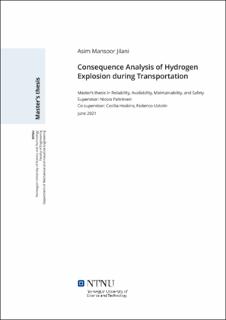| dc.contributor.advisor | Paltrinieri, Nicola | |
| dc.contributor.advisor | Haskins, Cecilia | |
| dc.contributor.advisor | Ustolin, Federico | |
| dc.contributor.author | Jilani, Asim Mansoor | |
| dc.date.accessioned | 2021-10-13T17:28:30Z | |
| dc.date.available | 2021-10-13T17:28:30Z | |
| dc.date.issued | 2021 | |
| dc.identifier | no.ntnu:inspera:78072655:51192563 | |
| dc.identifier.uri | https://hdl.handle.net/11250/2799899 | |
| dc.description.abstract | Nye karbonutslippsmål for 2050 er i topp interesse for markedet for hydrogen som en alternativ energikilde. MCE, en leverandør av løsninger for veitransport, ba om støtte til planlegging og beslutningstaking angående muligheter for transport av komprimert hydrogengass.
Oppgavearbeidet er en videreføring av spesialiseringsprosjektet høstsemesteret 2020 rettet mot domenet for risikoanalysen av lagringsutstyret under transport, spesielt for komprimerte hydrogentanker. Oppgaven presenterer risikoanalysen av de potensielle konsekvensene basert på flere scenarier angående transport av komprimert hydrogentank og førerhusets sikkerhet. Hovedfokus har vært på konsekvensmodellering av brudd i hydrogentanken ved bruk av computational fluid dynamics (CFD) modellering for å simulere og evaluere virkningen av eksplosjonsbølgen generert på førerhuset og det omkringliggende miljøet når det gjelder trykk og temperaturprofiler. Resultatene støtter analysen av tiltak som er nødvendige for å forhindre og minimere konsekvensene. Imidlertid gjenstår det ytterligere arbeid med å etablere klare retningslinjer for å sikre transport av hydrogengass i form av forskrifter som den European Agreement concerning the International Carriage of Dangerous Goods by Road (ADR). | |
| dc.description.abstract | New carbon emissions targets for 2050 are peaking interest in the market for hydrogen as an alternative energy source. MCE, a supplier of road transportation solutions, requested the support of their planning and decision-making regarding options for the transport of compressed hydrogen gas.
The thesis work is the continuation of the specialization project of fall semester 2020 directed towards the domain of the risk analysis of the storage equipment under transport in particular for compressed hydrogen tanks. The thesis presents the risk analysis of the potential consequences based on multiple scenarios regarding the transportation of the compressed hydrogen tank and the driver’s cabin safety. The major focus has been on the consequence modeling of rupture of the hydrogen tank using computational fluid dynamics (CFD) modeling to simulate and evaluate the impact of the blast wave generated on the driver’s cabin and the surrounding environment in terms of pressure and temperature profiles. The results support the analysis of measures required to prevent and minimize the effects of the consequences. However, additional work remains toward establishing clear guidelines for safeguarding the transport of hydrogen gas in terms of regulations such as the European Agreement concerning the International Carriage of Dangerous Goods by Road (ADR). | |
| dc.language | eng | |
| dc.publisher | NTNU | |
| dc.title | Consequence Analysis of Hydrogen Explosion during Transportation | |
| dc.type | Master thesis | |
